‘No points of interest’: Driving the ‘loneliest road in the US’
By Keith Austin
In 1986, Life magazine described Nevada’s Route 50 as “totally empty”. An American Automobile Association spokesperson, quoted in the story, said: “There are no points of interest. We don’t recommend it.”
Landed with this lemon, the Nevada tourism bigwigs began making lemonade. They turned the put-down into a marketing slogan and encouraged people to drive what Life had called “the loneliest road in America”.
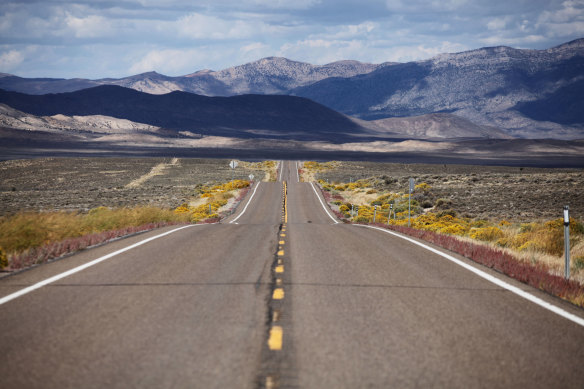
Route 50: America’s “loneliest road”.Credit: iStock
Thirty-eight years later, the name persists but Route 50 is far from lonely. Indeed, by Australian outback driving standards, it’s positively jam-packed. From Lake Tahoe in the west, where it enters the state from California, to the sun-baked plains of Baker in the east, where it disappears into Utah, it’s a 658-kilometre adventure through the guts of Nevada and the soul and history of America.
Go west, young man, they said in the late 1800s, and many hundreds of thousands did just that, tempted away from the east coast by the lure of a better life and rumours of the rich veins of gold and silver just begging to be dug out of the virgin earth.
Route 50 wends its way through the detritus of that westward expansion – a journey through mountain ranges, valleys, rugged forests and vast, scrubby prairies peppered with ghost towns, abandoned silver mines, stagecoach stops and roadhouses where the famed Pony Express mail riders used to change horses and grab a bite to eat.
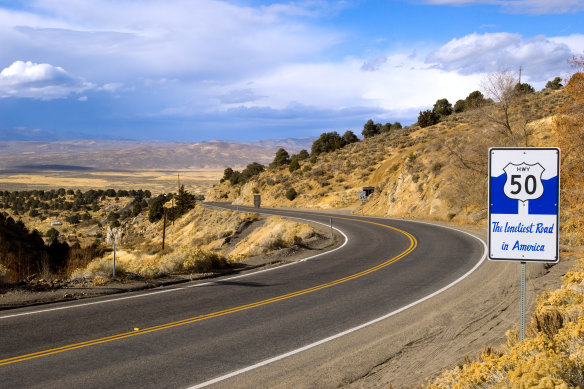
The name persists but the route is far from lonely.Credit: iStock
Today, the horses have been replaced by horsepower and the beat of hooves by the roar of the engine but the landscape remains pretty much the same. Here, the highway rolls on, arrow-straight, across a plain lined with the seemingly ubiquitous yellow rubber rabbitbrush shrub. Eventually, it reaches the foothills of a far-off mountain peak where, thanks to the shimmering heat haze, it melts into infinity. It’s not hard to imagine what those early pioneers went through.
It’s safe to say, though, that none of them ever came face to face with the Monster at Middlegate Station. Built in 1859 by the Overland Stage & Freight Company to service the gold mines at Tonopah and Ely, Middlegate also became a changing station for the Pony Express (which, despite its near-mythical status, only lasted 18 months before going bankrupt).
A roadhouse is still there today, a one-storey affair sitting just off yet another flat, straight stretch of Route 50 between Fallon and Austin. Beneath the Middlegate Station sign, an old jalopy and abandoned farm equipment are gently rusting. On the building’s ramshackle wooden exterior a sign reads: “Welcome to Middlegate Station, middle of nowhere, elevation 4600 feet. Population 17.” A crossed-out “18″ speaks of either a joke or a local tragedy.
Inside, Middlegate Station is a low-lit mix of bar, restaurant and mini-market where locals sip beer and munch on burgers amid a decor rife with Wild West memorabilia, horned skulls and a ceiling pinned with dollar bills. A red supermarket shopping basket filled with zucchini and squash has a hand-written sign taped to it. FREE!!! it says. In the mini-mart you can buy bottles of house-made Middlegate Madness hot sauces, or a Bible.
What catches our eye, though, is the Middlegate Monster. This enormous multi-layered burger comes with onion rings, fries and a free T-shirt if you can eat it all. Rules: You cannot use the restroom once the challenge begins. There is no time limit. You must eat everything but the skewers. If you can’t keep the Monster down, you lose.
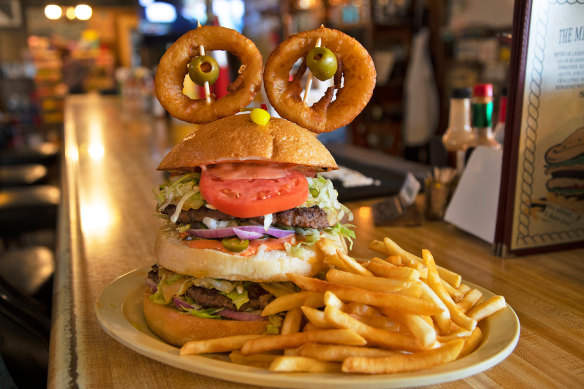
If you can’t keep the Middlegate Monster down, you lose.
Two of us step up to the challenge. After all, how big can one burger get? Answer: bigger than your head. Long story short: neither of us has the T-shirt. Very few have, according to the locals.
Middlegate Station is also an Official Stamp Location where you can get your Route 50 Survival Guide validated. This little tourism “passport″ includes information on eight of the major towns along the loneliest road and space on each for an official stamp. At the end of your trip, tear off the postage-paid postcard at the back of the booklet and Nevada Tourism will send you a Highway 50 Survivor souvenir and certificate.
Not that today’s Route 50 is something to survive any more. Carving its way across the middle of Nevada it stitches together Genoa in the west to the towns of Fallon, Austin, Eureka, Ely and Baker. Between them, vast stretches of, at least in Life‘s opinion, naught.
But nothing could be further from the truth. Route 50 is a cornucopia of far-flung delights, from the stones and rocks people have rearranged to spell out names and messages along the side of the highway to the 6000-year-old rock art petroglyphs at Grimes Point, the surreal appearance of a massive sand dune at the Sand Mountain Recreation Area and on to the Lehman Caves and Dark Skies of the Great Basin National Park.
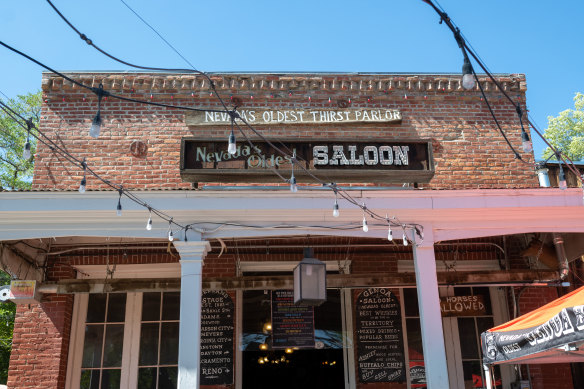
Genoa Bar is the state’s oldest.
There is beauty in the nothingness, too, of course. Perhaps not if you’re trundling along in a 19th-century wagon train and looking at how far you have to go, but Route 50 is a well-maintained highway which brings those vast Wild West vistas under some sort of control. Australians, particularly, will appreciate the desolate, almost frightening, beauty of a sky that reaches down to the horizon like an upturned bowl – and of a road that runs across it, dead straight, no deviations, like the slice of scalpel.
And then come the towns, dotted along the slice like sutures. Pretty, manicured Genoa, for instance, is Nevada’s oldest town, founded in 1851 and home to the Genoa Bar, the state’s “oldest thirst parlour since 1853″.
Or the wonderfully named Eureka (“the Friendliest Town on the Loneliest Road”), once a 19th-century boomtown that boasted 50 mines yielding gold, silver, lead, and zinc. It’s a prosperity that’s obvious along the main road through town, dotted as it is with opulent brick buildings – such as the Eureka Opera House and the Italianate-style Eureka Courthouse – that wouldn’t look out of place in any major city. Take time out, as we did, to visit the Afterlife antiques and oddities shop, which boasts of having “dead people’s things for sale″ and where you might even get a ghost tour.
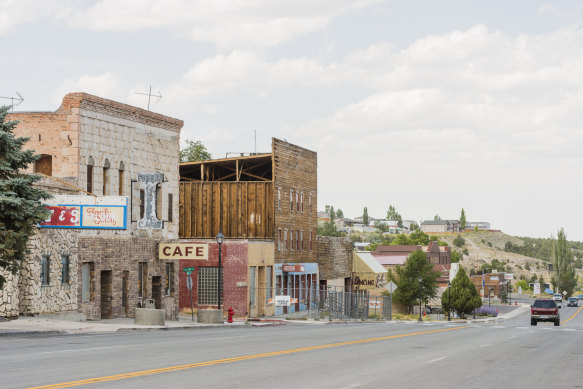
Eureka: “the Friendliest Town on the Loneliest Road”.Credit: iStock
One of the major attractions for someone with my surname is the town of Austin. Once one of central Nevada’s most prosperous mining camps it is today more of a blink-and-you’ll-miss-it kind of town. As you might imagine, there is now plenty of pictorial evidence of this Austin in that Austin.
We spend the night in the Austin motel and eat out at Grandma’s (“Austin’s Living Room”). It is about the only place in town to eat unless you like whipping up a feast from gas station shelves. The food isn’t fancy but it’s tasty and there’s plenty of it.
Austin isn’t quite yet a ghost town but it’s heading that way. An “on-life-support” town, perhaps. Even the Official Highway Survival Guide is forced to stoop to mentioning that the town’s “interpretive park” (which itself is a bit of a ghost as we didn’t find it) has “some spiffy restroom facilities”. If that’s not 21st-century speak for “the end is nigh″ I don’t know what is.
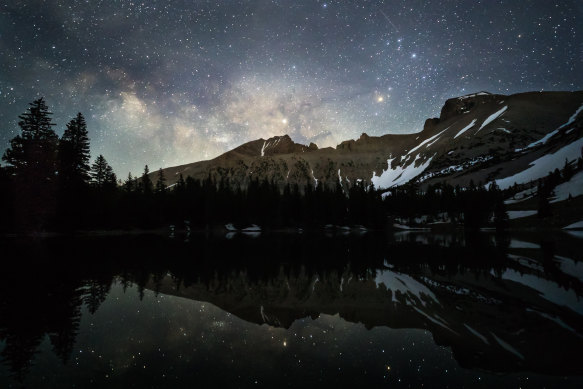
At Great Basin National Park the Milky Way, galaxies and constellations sparkle like diamonds on black velvet.Credit: iStock
Perhaps the best thing about Austin is the story of the Sazerac Lying Club. In 1873, journalist Fred H. Hart was editor of the local Reese River Reveille, based in Austin, a town which was, according to Hart, “a quiet place in which anything of a startling nature … seldom transpires”. Stuck for news, Hart repaired (as journalists are wont) to the local watering hole, The Sazerac. Here, he discovered a feast of exaggerated stories and downright lies, told by local ranchers, miners, and stage drivers.
Hart began recording the tales and the Sazerac Lying Club was born, with members competing for the title of “Monumental Liar of America″. An eponymously titled book followed in 1878 and was a huge success.
At the far eastern end of Nevada’s section of Route 50 is Baker, a small, arty community where the white clapperboard Bristlecone General Store offers groceries, decent coffee, general tourism advice and a small but perfectly formed selection of books. For more substantial fare, dinner at the Sugar, Salt and Malt restaurant directly opposite is excellent.
We hike in the Great Basin National Park and join an underground tour of the nearby Lehman Caves but one of the top attractions here are the stars. Like the Warrumbungles in Australia, this is an international Dark Sky Park where the Milky Way, galaxies and constellations sparkle like diamonds on black velvet.
Life was wrong. Even in the nothing, there is something.
The writer was a guest of Travel Nevada.
THE DETAILS
We flew United Airlines from Los Angeles (LAX) to Reno-Tahoe International Airport. United flies to LAX daily from all major Australian airports. See www.united.com for details.
STAY
The Silver Legacy Resort, Reno has rooms from $US61.50 a night ($94.40). See caesars.com The Hyatt Regency Lake Tahoe Resort from $US317.41 a night. See hyatt.com
The Cozy Mountain Motel in Austin from $US115 a night. See cozy-mountain-motel.business.site The Stargazer Inn, in Baker from $US124.85 a night. See stargazernevada.com
All the above include taxes and charges. Some US hotels and resorts charge a hefty “resort fee”. Check the small print before booking.
EAT
The Middlegate Monster (and its evil, hotter twin, the Fire Monster) costs $US24.95 (about $40). The Sugar, Salt and Malt (saltandsucre.com) restaurant is one of the few places to eat dinner in Baker. Be aware that it closes at 8pm.
VISIT
The Lehman Caves are about eight kilometres from the town of Baker and can only be visited with a park ranger on a guided tour. Advance booking recommended. Visitors 15 years and under need adult supervision. See nps.gov for more details. The Great Basin National Park grounds are open 24 hours a day year round.
MORE
Sign up for the Traveller Deals newsletter
Get exclusive travel deals delivered straight to your inbox. Sign up now.